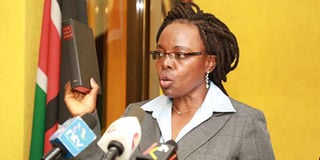How delayed funding messed up counties

Controller of Budget Margaret Nyakang'o is sworn in on December 4, 2019 at the Supreme Court. PHOTO | FILE | NATION MEDIA GROUP
What you need to know:
- Counties’ quest to speed up economic growth hit headwinds between July and December 2019 because not many investments were made in key areas such as infrastructure and health.
Review report in the first half of 2019/20 financial year indicates that less development spending stifled investment, which denied the economy the impetus it needs to grow.
Delayed disbursement of funds to county governments in the first six months of this financial year affected crucial plans on roads, water, agriculture and health sectors, the latest report by Controller of Budget Margaret Nyakang’o shows.
This means that counties’ quest to speed up economic growth hit headwinds between July and December 2019 because not many investments were made in key areas such as infrastructure and health.
An analysis of the County Governments Budget Implementation Review report in the first half of 2019/20 financial year indicates that less development spending stifled investment, which denied the economy the impetus it needs to grow.
The disbursement schedule shows that by December 15, counties ought to have received Sh140.53 billion.
This amount translates to 44.4 per cent of the annual equitable share allocation of Sh316.5 billion.
But the National Treasury had only disbursed Sh117.29 billion, accounting for 37.1 per cent of the annual equitable share of revenue.
“It is recommended that the National Treasury should disburse funds to the counties on a timely basis to ensure that budget implementation is not adversely affected,” Dr Nyakang’o said.
During the period between July and December, county governments were unable to pay for drugs, water and electricity and run development projects over the stalemate between the national government and governors on sharing of revenue.
During the six-month period, counties spent Sh22.77 billion on development, representing an absorption rate of 11.6 per cent of the annual development budget.
This is a decline from 13.2 per cent reported over a similar period the previous financial year, 2018/2019, when the development expenditure was Sh24.36 billion.
Murang’a, Kakamega, and Kisii counties attained the highest absorption rate at 32 per cent, 24.2 per cent and 23.9 per cent respectively.
But Samburu and Lamu counties did not report any expenditure on development activities, hurting job creation and infrastructure projects.
County authorities are the biggest buyers of goods and services at the grassroots, meaning that reduced spending on projects has a negative impact on job creation and cash in circulation.
Dr Nyakang’o recommended all counties to prioritise implementation of development projects in order to improve the living standards of their citizens.
This is in line with Section 107(2) (b) of the Public Finance Management (PFM) Act, 2012, which provides that over the medium term, a minimum of 30 per cent of the county governments budget shall be spent on development.
This report has also identified challenges, which hampered effective execution of the budget. It singles out high expenditure on personnel emoluments, delays in disbursement of equitable share by National Treasury, and low expenditure on the development budget.




